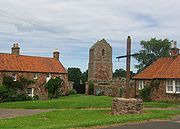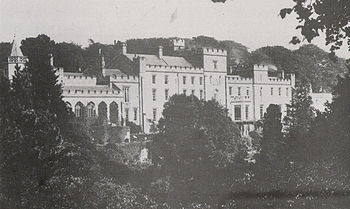
Stenton
Encyclopedia

East Lothian
East Lothian is one of the 32 council areas of Scotland, and a lieutenancy Area. It borders the City of Edinburgh, Scottish Borders and Midlothian. Its administrative centre is Haddington, although its largest town is Musselburgh....
, Scotland
Scotland
Scotland is a country that is part of the United Kingdom. Occupying the northern third of the island of Great Britain, it shares a border with England to the south and is bounded by the North Sea to the east, the Atlantic Ocean to the north and west, and the North Channel and Irish Sea to the...
. It is bounded on the north by parts of the parishes of Prestonkirk
Prestonkirk Parish Church
Prestonkirk Parish Church is a Church of Scotland parish church at East Linton, in the parish of Traprain, East Lothian, Scotland, UK, close to Preston Mill, Smeaton, Phantassie, and the River Tyne.-Building:...
and Dunbar
Dunbar
Dunbar is a town in East Lothian on the southeast coast of Scotland, approximately 28 miles east of Edinburgh and 28 miles from the English Border at Berwick-upon-Tweed....
, on the east by Spott
Spott, East Lothian
Spott is a small village on the eastern fringes of East Lothian in Scotland, just over south-west of Dunbar. The village straddles an unclassified road leading from the main A1 highway at .- History :...
and on the west by Whittingehame
Whittingehame
Whittingehame is a parish with a small village in East Lothian, Scotland, about halfway between Haddington and Dunbar, and near East Linton. The area is on the slopes of the Lammermuir Hills...
. The name is said to be of Saxon derivation. In earlier times, when names were often written phonetically, it was often spelt Stanton, Stanetoun, or even Steinton. The village contains a number of good houses, a school, and a church.
Geography
A portion of the parish formerly insulated from the main part stretches into the Lammermuir HillsLammermuir Hills
The Lammermuir Hills, usually simply called the Lammermuirs , in southern Scotland, form a natural boundary between Lothian and the Scottish Borders....
to a distance of about 8 miles from the village, and is bounded on the south by the Whiteadder Water
Whiteadder Water
Whiteadder Water is a river in East Lothian and Berwickshire, Scotland. It also flows for a very short distance through Northumberland before joining the River Tweed...
, and Berwickshire
Berwickshire
Berwickshire or the County of Berwick is a registration county, a committee area of the Scottish Borders Council, and a lieutenancy area of Scotland, on the border with England. The town after which it is named—Berwick-upon-Tweed—was lost by Scotland to England in 1482...
.
Springs and streams abound in many parts of the parish. A rivulet which rises in the high ground of Stoneypath farm, runs through the Ruchlaw estate (ancient seat of the Sydserf family) and joins the Whittinghame Water a mile or so further on. Pressmennan lake
Pressmennan Lake
Pressmennan Lake is a lake in East Lothian in Scotland.It is an artificial reservoir constructed in 1819. It lies in a gully in the Lammermuir Hills, above the village of Stenton in East Lothian...
, at the east end of a deep natural valley, with Duchrie Dod Hill and Pressmennan Hill on the south and east is about one mile south of the village of Stenton. It was artificially formed about the year 1819 by William Hamilton-Nisbet of Biel
Biel, East Lothian
Biel is a village in East Lothian, Scotland, UK, to the south of Dunbar, off the B6370 road. It is situated on the Biel Estate, close to Biel House...
(1747-1822), and is two miles in length and of good breadth. It is the only loch of any consequence in East Lothian
East Lothian
East Lothian is one of the 32 council areas of Scotland, and a lieutenancy Area. It borders the City of Edinburgh, Scottish Borders and Midlothian. Its administrative centre is Haddington, although its largest town is Musselburgh....
. The overflow water from the loch forms a pretty stream which runs past Broxburn, &c., and falls it the sea at Broxmouth, just south of Dunbar
Dunbar
Dunbar is a town in East Lothian on the southeast coast of Scotland, approximately 28 miles east of Edinburgh and 28 miles from the English Border at Berwick-upon-Tweed....
.
Early proprietors
Stenton had been a superiority of the Lauder of The Bass family from the 13th century until the middle of the 17th century. Henry the Minstrel records in his poem The WallaceThe Actes and Deidis of the Illustre and Vallyeant Campioun Schir William Wallace
The Actes and Deidis of the Illustre and Vallyeant Campioun Schir William Wallace, also known as The Wallace, is a long "romantic biographical" poem by the fifteenth century Scottish makar of the name Blind Harry probably at some time in the decade before 1488...
that William Wallace
William Wallace
Sir William Wallace was a Scottish knight and landowner who became one of the main leaders during the Wars of Scottish Independence....
rewarded Sir Robert de Lawedre with the lands of Stenton in 1297. Bain records long lists of Scots who have been forfeited of properties by the English King Edward III between 1335 - 1337: Robert de Lawedre 'fils' has forfeited half the domain lands of Stenton (where he is described as his father's son and heir), the other half being retained by his mother, Elizabeth. The Lauders retained Stenton parish down through the centuries: the Exchequer Rolls record that
Robert Lauder of The Bass
Robert Lauder of The Bass
Sir Robert Lauder of The Bass, was a Scottish knight, armiger, and Governor of the Castle at Berwick-upon-Tweed. He was also a member of the old Scottish Parliament...
was granted Sasine of Stenton in 1495, following the death of his father. In the National Archives (GD6/219) there is an extract contract of wadset (mortgage or security) between George Lauder of The Bass and Isobel Hepburne, his mother, and William Diksoun in Biel of the east half of the town and lands of Stentoun, barony of Biel, dated 3 August 1620 (recorded in the Books of Council and Session, 6 June 1623). This last Lauder laird of The Bass parted with Stenton in 1644.
Biel
The superiority of the lands of Biel were held until 1489 by the Dunbar family, former Earls of March. The Great Seal of ScotlandGreat Seal of Scotland
The Great Seal of Scotland allows the monarch to authorise official documents without having to sign each document individually. Wax is melted in a metal mould or matrix and impressed into a wax figure that is attached by cord or ribbon to documents that the monarch wishes to make official...
charter (number 1894) dated 12 September 1489 relates their sale, the King confirming a charter to "his armiger" Robert Lauder of Edrington
Edrington
Edrington is a medieval estate occupying the lower part of Mordington parish in Berwickshire, Scottish Borders, Scotland, five miles west of Berwick-upon-Tweed. From probably the 14th century, if not earlier, a castle occupied the steep hill above the mill of the same name on the Whiteadder Water...
, (from 1495 Robert Lauder of The Bass
Robert Lauder of The Bass
Sir Robert Lauder of The Bass, was a Scottish knight, armiger, and Governor of the Castle at Berwick-upon-Tweed. He was also a member of the old Scottish Parliament...
) (d. bef. Feb 1508), and his heirs, of the lands of Bele (sic), Johnscleuch, le Clyntis, all with their towers, mills etc., in the Barony of Dunbar, which had been formerly owned by Hugo Dunbar of Bele; plus the lands and mill of Mersington, Berwickshire, which Hugo Dunbar of Bele also resigned. Robert's wife Isabella, daughter of John Hay, 1st Lord Hay of Yester
John Hay, 1st Lord Hay of Yester
John Hay, 1st Lord Hay of Yester is the ancestor of the Marquesses of Tweeddale. He was created a Lord of Parliament on 29 January 1488 by James III of Scotland....
, is also mentioned. Biel and a number of other lands was made into a feudal barony.
When his grandson Robert Lauder of The Bass died in June 1576, he was succeeded by his son James Lauder, Dean of Restalrig, whom he at one time imprisoned in Biel Tower over religious matters. James Lauder apparently continued to reside there until he was murdered by a cousin "within his [James's] awin place of Beill" on October 4, 1580. Sixty-four years later, George, the last Lauder laird of The Bass sold the Biel estate to John Hamilton of Bromehill, who, in 1647, was raised to the title of Lord Belhaven and Stenton. Hamilton was a keen gardener, and laid out the still extant terraces from the Tower House down to the Biel Water.

Gothic Revival architecture
The Gothic Revival is an architectural movement that began in the 1740s in England...
additions" in red sandstone by architect William Atkinson for William Hamilton-Nisbet of Biel. At the west end was a large conservatory rebuilt in 1883 as a chapel. Some of these fittings were retained when the chapel and most of Atkinson's magnificent house were demolished in 1952. The house as it stood before demolition was 593 foot in length, its great length being relieved by the original Tower in the middle, and the turret of the chapel at the west end. The lower part of the square tower (today the east end of the present block) contains the walls of the original Pele which had barrel-vaulted rooms in the basement. The Tapestry Room was refitted by Robert Lorimer
Robert Lorimer
Sir Robert Stodart Lorimer was a prolific Scottish architect noted for his restoration work on historic houses and castles, and for promotion of the Arts and Crafts style.-Early life:...
in the early 20th century, and Country Life
Country Life (magazine)
Country Life is a British weekly magazine, based in London at 110 Southwark Street, and owned by IPC Media, a Time Warner subsidiary.- Topics :The magazine covers the pleasures and joys of rural life, as well as the concerns of rural people...
in 1902 thought Biel "deserved to be ranked among the finest of the great houses in Scotland". it owned the Pressmennan lake and built the house which was used as a game house for hunting and fishing. They sold it in the 1950's and is now a house.
Namesakes
StentonStenton (mansion)
Stenton, also known as the James Logan Home, was the country home of James Logan, colonial Mayor of Philadelphia and Chief Justice of the Pennsylvania Supreme Court....
, the country estate of James Logan
James Logan (statesman)
James Logan , a statesman and scholar, was born in Lurgan, County Armagh, Ireland of Scottish descent and Quaker parentage. In 1689, the Logan family moved to Bristol, England where, in 1693, James replaced his father as schoolmaster...
(now a museum and park well within the city of Philadelphia), was named for Stenton parish, which was the birthplace of Logan's father. Philadelphia currently has two Stenton Avenues, at least one of which gets its name from the Stenton estate.
See also
- Biel WaterBiel WaterThe Biel Water is a river running through the Biel Estate in Biel, East Lothian.It runs for 4.5 kilometres from the Luggate Burn and the Whittinghame Water, via Stenton, Biel House, West Barns, and finally to Belhaven Bay with its rather unusual bridge....
- List of places in East Lothian

